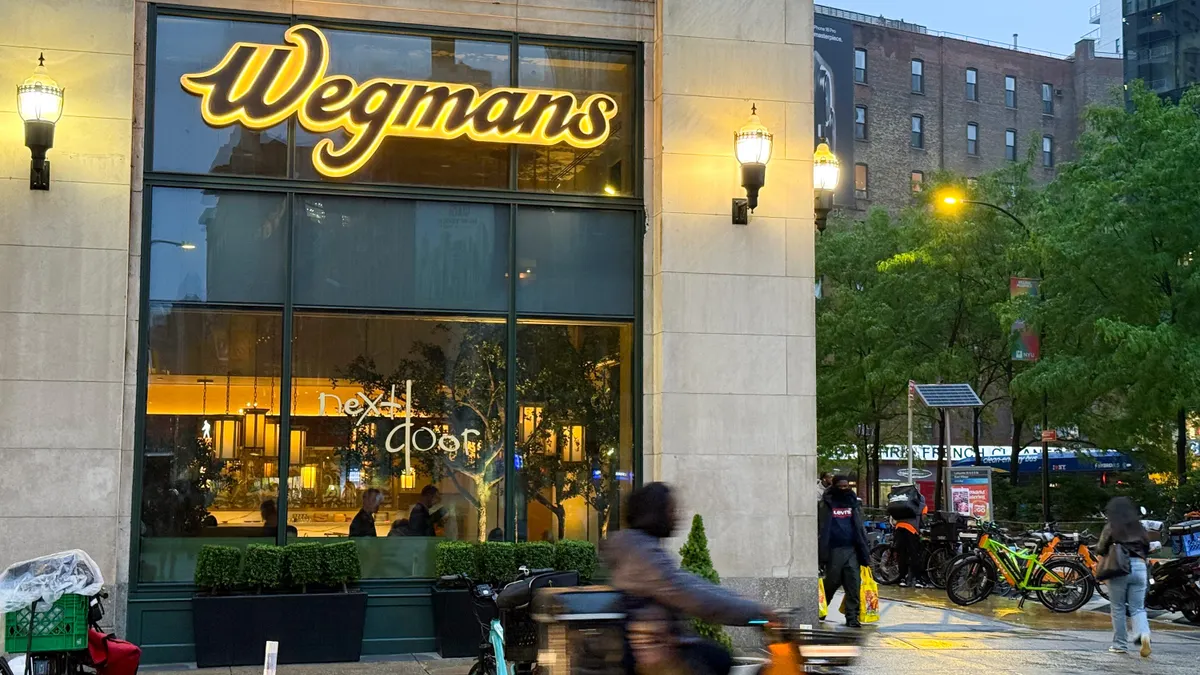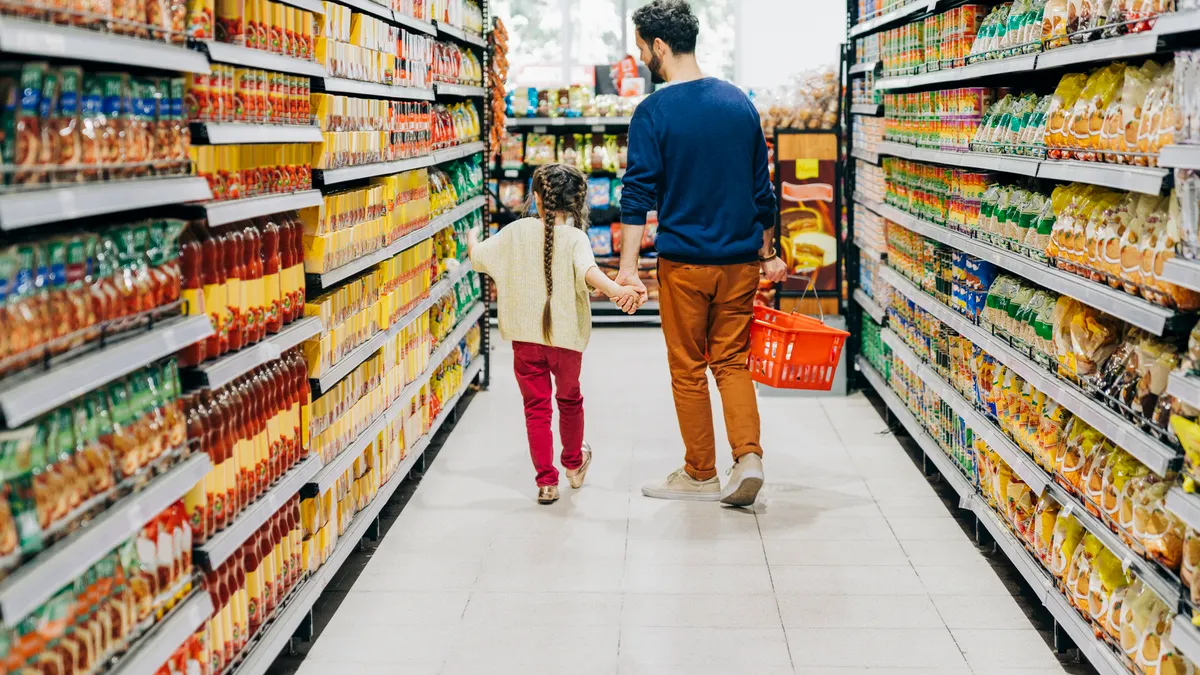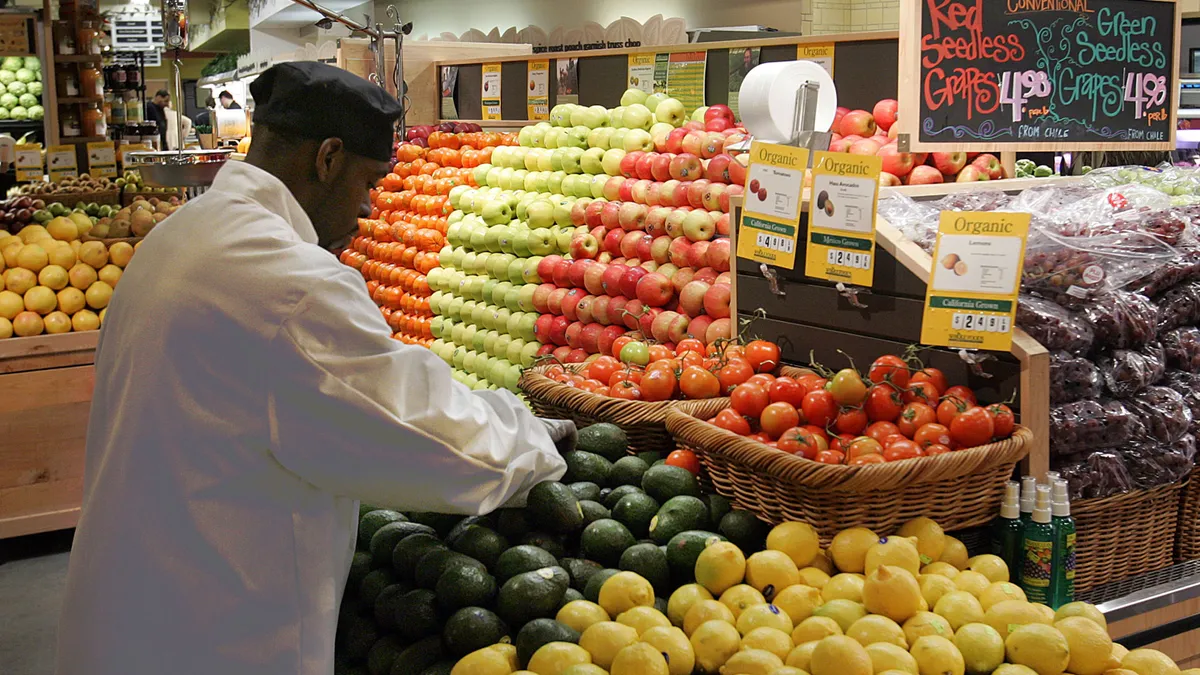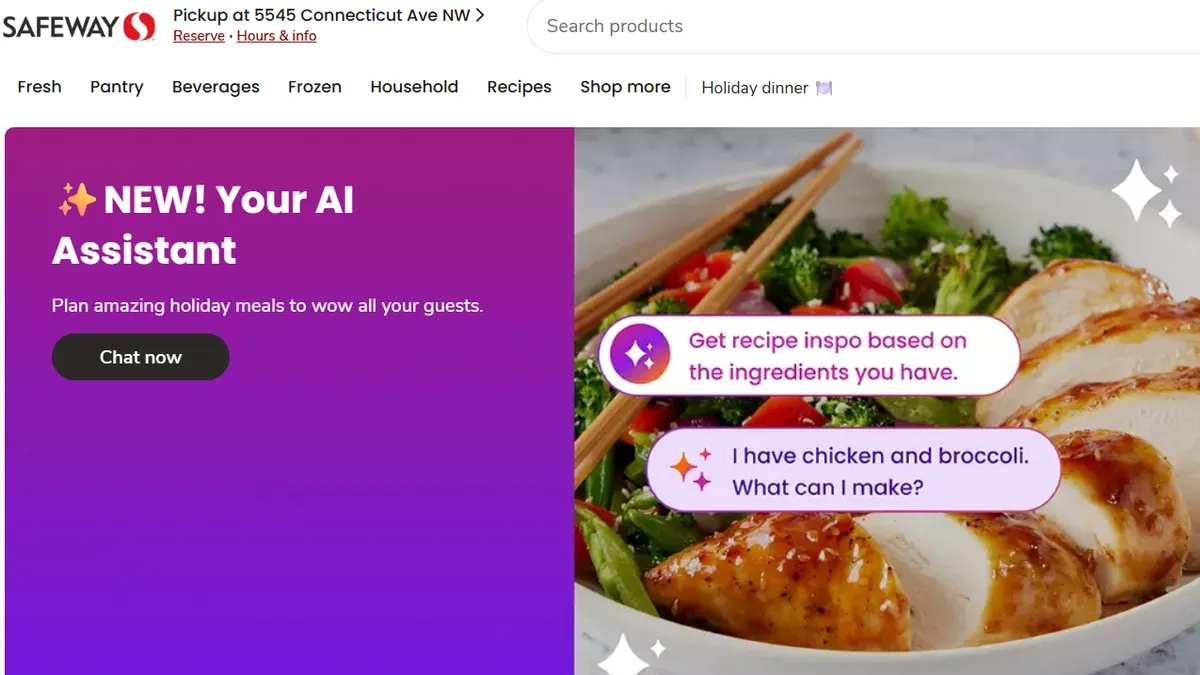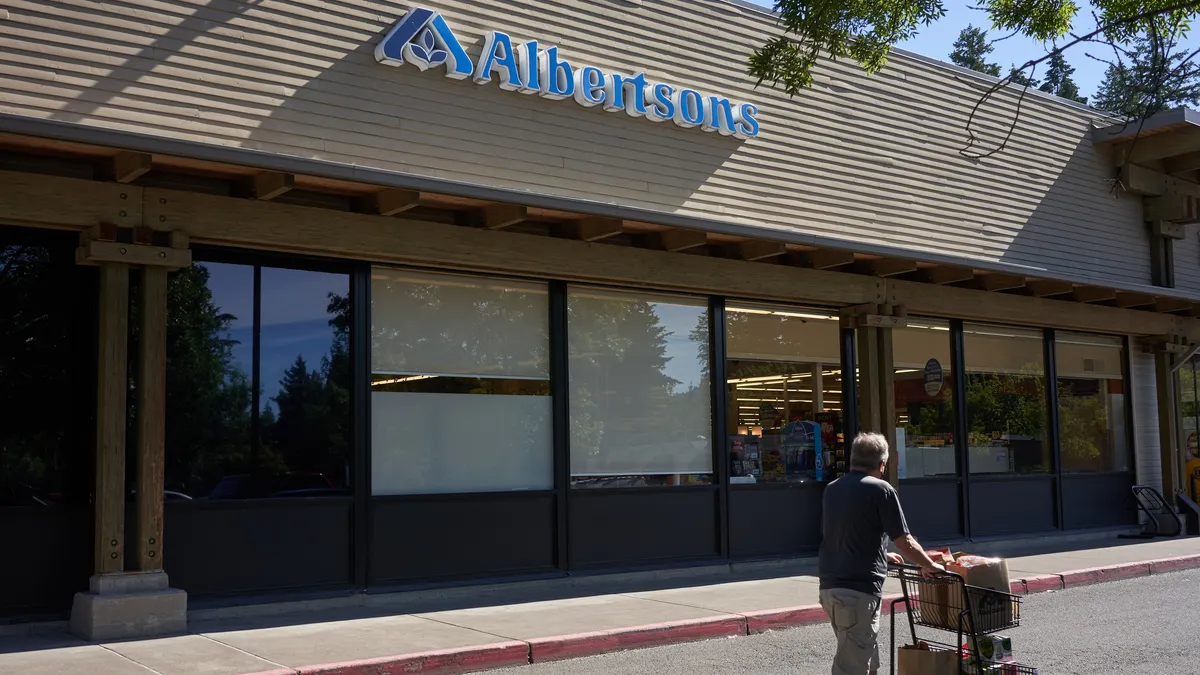When the coronavirus pandemic swept the U.S. last spring, Community Foods Market in Oakland, California, turned to free delivery to encourage seniors to shop online.
“Even though we were doing kind of everything to keep our store clean and sanitized daily and limit traffic coming into the store, I just was not that comfortable with the idea of encouraging seniors to come out at what was the peak of the first [COVID-19] surge,” said Brahm Ahmadi, CEO and president of the store.
The store sits just a few blocks from two large senior living facilities and serves a senior population that has a high percentage of low-income people and households without cars, Ahmadi said.
With the help of grant funding and a GoFundMe campaign, the grocery store rolled out the free senior delivery as one of several initiatives to help vulnerable shoppers, Ahmadi said. “Over time, some of those seniors who are repeat [customers], they've gotten pretty savvy with the website,” he said.
Community Foods is one of the many grocery stores that focused their attention on helping older shoppers navigate e-commerce as a way to avoid COVID-19 exposure and address mobility challenges. Now, those grocers are investing in making online shopping a better experience for seniors — a goal that comes with its own unique set of challenges.
Instacart noted in a report earlier this month that it saw a 9% increase in seniors using its service — the largest bump among age groups — between the first and fourth quarters of 2020. However, while the rate of shoppers ages 60 and older jumped at the start of the pandemic, according to Brick Meets Click, the retail consulting firm's latest data indicates that many senior shoppers are headed back to in-store shopping.
David Bishop, partner at Brick Meets Click, said there’s a growing urgency among tech-facing retailers to serve seniors because of the demographic's size along with focusing on compliance with the Americans with Disabilities Act (ADA), which requires retailers to meet certain levels of accessibility.
“The senior consumer, [ages] 65 and older, is growing at a rate that's almost three times that of the rest of the population … Those over 65 are going to represent a larger share of the overall market from a consumer spending perspective,” Bishop said. “If we want to win in five years, we need to figure out how we can do a better job serving that portion of the market.”
Designing with accessibility in mind
To better understand how seniors use online shopping, Bishop recently turned to a familiar source: his mother, who is in her 70s. Last March, Bishop began observing her while she shopped, filming her as she placed an order for more than 20 items on Instacart.
Bishop noticed that building an online cart of more than a dozen items was a tedious process for her, and that she had trouble, at times, finding the items she wanted. She had difficulty getting rid of pop-up screens, navigating product substitutions and determining how to add more than one of any given product to her cart. When it came time for her to check out, Bishop added his mobile number to the order because, while his mom has a cell phone, she didn't want to use it to receive updates about the order.
Because older consumers can face increasing difficulty with mobility and cognitive abilities and, potentially, a steeper learning curve when adapting to online shopping, Bishop recommends that the grocery industry invest more resources into understanding how age impacts technology use.
"The big challenge when seniors are using e-commerce is, No. 1, dexterity with their hands and quality of their eyesight," said Sylvain Perrier, president and CEO of grocery e-commerce platform Mercatus Technologies.
Internet availability and smartphone penetration can also pose barriers. Among people ages 65 and older, 73% use the internet, while 53% own smartphones, according to The Pew Research Center in 2019.
To better serve senior shoppers, grocers and their tech firms may need to rethink design elements of their e-commerce sites, like adding screen readers — assistive technology that turns online text and images into speech or braille output — and increasing font sizes.
"Is the sign-up process easy? Is adding items to a basket easy? Are they getting the quantities right?" Perrier said. Mercatus has teamed up with Accessible360, a digital accessibility auditing firm, to help with the company with ADA compliance and uses tools like usertesting.com to launch focus groups of specific demographics to receive user feedback.
Grocers often include a variety of features on their e-commerce websites, like coupons, flyers, recipes and more, but those additions can make navigating the digital aisles overwhelming and confusing to older shoppers, Perrier said.
For seniors, "the big hump is the first order," he noted. Having features that allow seniors to shop items from a previous order or offer prepackaged product bundles make it easier to build their carts, he said.
"It's not a hard problem to solve from a web perspective and even a mobile perspective," Perrier said. "Is there enough money? Is it worthwhile for a retailer to do it?"
In a UX case study, Megha Goyal, a product designer for GoFood, an instant food delivery service under Indonesia-based Gojek, designed an e-commerce grocery product geared toward people ages 55-60, looking to solve three main challenges: vision, motor control and cognition.
To boost the visibility of relevant buttons, Goyal added icons to the “Cart” and “Search” buttons and spelled out “MENU” instead of using the hamburger menu icon. The display interface included both regular and large display size options. Additionally, Goyal included a scroll bar on the right side for users who might not be as familiar or comfortable with the scrolling gesture on touchscreen devices.
To make platforms more visually accessible, Goyal recommends keeping the font size 14 pixels or larger and buttons at least 48 by 44 pixels, picking a legible font, allowing for customizable display size and creating contrast between the background and text.
Local Express, a grocery e-commerce platform provider, has had some retail partners request larger pictures of products to make it easier for shoppers to see them, said Dennis Acebo, the company’s vice president of customer success. “We had some [retail partners] where we did have to enlarge the items so they can understand and see what that item is, so if they click on it, they can see the item, much larger,” Acebo said.
One feature, in particular, that Acebo said is useful is allowing shoppers to write notes for each item when they add them to the cart.
Online grocery shopping has also opened up avenues to support budget-conscious seniors. Grocers can consider creating deals targeting certain age demographics. For example, Local Express offers retailers the ability to create special departments stocked with essential items for seniors as well as special discounts targeted to them.
Senior support solutions
Key to engaging seniors online is helping them get past their first few orders, Bishop said, which tend to be most challenging. One of the ways grocers and e-commerce companies are doing this is by creating dedicated support lines.
Last spring, Texas grocer H-E-B and its on-demand delivery service Favor debuted a Senior Support phone line that allows shoppers ages 60 and older that live within eight miles of an H-E-B store to place same-day orders, along with a curated list of grocery essentials that's available to order over the phone and online. With the curated list, customers can select items like milk, eggs and bread, and add up to 25 custom items per order.
To help seniors who want to place online orders, Favor has a YouTube video showing how to place an order. While it’s not clear how many people might use video tutorials, Bishop said they could help demystify the online shopping experience, along with well-written FAQs.
Instacart launched its own Senior Support Service in late 2020 for people over the age of 60 in the U.S. and Canada. By offering a phone service, Instacart said that support staff and customers are able to have longer and more in-depth conversations, noting shortly after its launch that contacts with the Senior Support Service lasted on average 20% longer than traditional customer service contacts. The service aims to replicate the personalized, high-touch assistance seniors would get from friends or family, a spokesperson said.
After placing one to two orders, seniors tend to need less support and go on to buy 25% more frequently than younger customers, the spokesperson said.
At the start of April, Instacart said nearly 300,000 seniors have learned how to use Instacart through the support center, which has been growing by roughly 1,000 senior customers daily. The service has had some of its largest concentrations of users in San Diego, Orange County and West Los Angeles, California; Boca Raton, Florida; New York City’s Brooklyn and Queens boroughs; and Philadelphia, the spokesperson said.
Meeting expectations offline
Experienced grocery shoppers may be less forgiving of the rough spots of grocery e-commerce. Online shopping's appeal to older consumers can become hindered if the product quality and grocery bag hand-off doesn't match shoppers' expectations.
When the pandemic hit, Jeanne Cope, 67, and her husband, who are at high risk of severe complications from COVID-19, turned to Instacart — first with Safeway and then Raley's — for contactless delivery to their home in the California Bay Area.
Over the past year, the Copes have experienced some hiccups with their online orders, like a missing bag of groceries that was resolved through customer service, and a package of moldy grapes. For one order, the expiration date for the milk was a few days after the delivery date. “If I was shopping myself, I would have picked something a little farther out,” Cope said.
"Those over 65 are going to represent a larger share of the overall market from a consumer spending perspective. If we want to win in five years, we need to figure out how we can do a better job serving that portion of the market.”

David Bishop
Partner, Brick Meets Click
On the other side of the country in Brooklyn, Ellyn Toscano, 65, said she stopped buying avocados "or something that's really fragile or temperamental" online due to issues with ripeness and quality. She switched her online grocery shopping to Whole Foods, which she said offered better quality produce.
For Toscano, produce quality is important because she is a vegetarian. After adjusting her shopping habits, she's found that online grocery shopping, for the most part, has met her dietary needs and, in some ways, inspired new meal ideas, along with saving her from carving out time in her busy work schedule for in-person shopping.
Bishop encourages grocers not to overthink solutions. “I almost think the simplest answer actually will come from seniors helping seniors.”
To that end, he said grocers could rely on seniors as ambassadors to promote e-commerce.
“I think the idea of using like individuals, in terms of age, as the brand ambassadors is really important and not to be understated, simply because they'll communicate and relate to each other in a very different way in terms of their orientation to use of technology [and] to their empathy to one another,” Bishop said.
Acebo of Local Express said grocers should include younger age groups when marketing their e-commerce services for seniors, since elderly shoppers often get assistance from friends and family. Acebo cited his 90-year-old father as an example
“My siblings, we all take turns ordering for him,” Acebo said. “He has access to the internet so he can look, but we know he would have a very difficult time trying to go through the ordering process.”
Promoting services across age groups can also incentivize people helping seniors to shop online themselves, Acebo said. Local Express’s discussion with grocery partners reveals there are a lot of people shopping for seniors who find pickup appealing.
Acebo said Local Express has turned to targeted email and messaging campaigns, along with ad campaigns through Facebook and Google Ads and Facebook posts to help stores reach seniors. Offline, Local Express helps stores create flyers, window stickers, bag stuffers and banners — strategies that can boost awareness of online offerings.
Word of mouth can also be effective. For example, Toscano credits her daughter with introducing her to Misfits Market, a subscription-based e-commerce site that sells “ugly” produce, about six months before the pandemic started.
Ahmadi of Community Foods said he relied on word-of-mouth, in-store signage and promotions with the help of local community organizations and senior home facility operators. He plans to start winding down the free delivery service in June unless a surge of COVID-19 cases prompts an extension. Looking forward, he expects some seniors will continue to shop online, while others will return to the store.
While Cope said online grocery shopping has "run very smoothly," she misses socializing with her friends while grocery shopping and has resumed her usual routine of going to Safeway, Sprouts Farmers Market and Trader’s Joe now that she is fully vaccinated against COVID-19.
For others, like Toscano, grocery shopping has become a convenient mix of in-store and online.
"I still go to grocery stores but mostly for convenience, or when I don't have time, I order online from Whole Foods," Toscano said.







